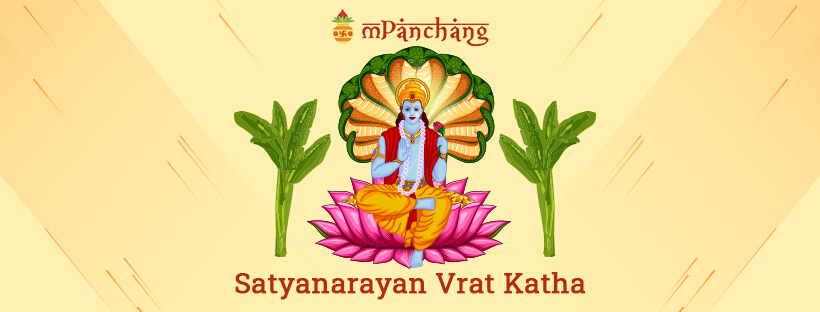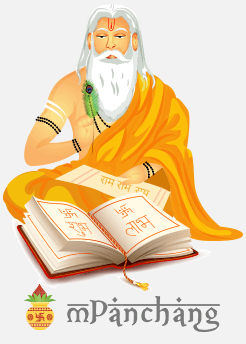Satyanarayan Vrat Katha is the process of worshipping the “highest truthful being.” Indirectly Lord Vishnu is worshipped on this day and Satyanarayan Vrat is a vow or in short an obligation, humans often fulfill. Satyanarayan Vrat Katha ensures humans are blessed by health, wealth and prosperity. Even on social functions some people prefer keeping a Satyanarayan Vrat Katha or Satyanarayan Katha.
Satyanarayan Vrat
Satyanarayan Vrat is mentioned for the first time in the Purana. Skanda Purana mentions Reva Kanda by Suta Puranik and it was delivered to the Rishis in Naimisharanya. The details of the Satyanarayan Vrat Katha are mandatorily recited every time someone keeps the Pooja. Satyanarayan Vrat is quite popular in almost all parts of India and regions of Gujarat, Assam, Bengal, Maharashtra, Telangana, Bihar, Karnataka, Andhra Pradesh, Odisha and Manipur.
When do people observe Satyanarayan Vrat?
Satyanarayan Bhagwan Katha is recited and observed primarily on the occasions of Poornima, Ekadashi, Kartik Poornima, Vaisakh Poornima, solar eclipses, or during Sankranti. Usually Asadha Chandra Masa is an exception to the recitation of the Satyanarayan Vrat Katha. So, mainly the Satyanarayan Pooja dates would very much be these personal occasions and other festivals.
Even special days like marriage days, birthdays, during our small successes in life, during Griha Pravesh (house warming ceremony), and many more such smaller occasions are reasons for reciting the Satyanarayan Puja Katha.
You can do a Satyanarayan Bhagwan Katha any day, and is not a Puja that you can do only on simpler occasions but also on any occasion that holds even little significance in your life. It is especially auspicious on a Poornima and it is more apt to perform the Pooja in the evening. But, you can also opt for this Pooja to be performed in the evening.
Details of observing Satyanarayan Vrat
The Satyanarayan Vrat Katha is an extremely simple Pooja. It can be done by anyone. Even you can do it, and a priest is usually not necessary for performing the Satyanarayan Pooja at home. Originally, the instructions were given by Rishi Narada Muni. While touring the Earth, Narada Muni noted that there was a lot of suffering mainly due to malnutrition around the surface of the Earth.
So, he went to Lord Vishnu and described the entire condition on Earth. Lord Vishnu told Lord Narada the specific ways in which Satyanarayan Vrat could save people from dying of malnutrition.
The key instruction from Lord Vishnu was to invite a lot of people- friends, relatives and neighbours for the observance of Satyanarayan Vrat Katha. Fruit was to be fed to all of them and this alone could eliminate the deficiencies amongst people.
Preparation of Satyanarayan Katha
According to customs and traditions, on the day of Satyanarayan Swami Katha, one must abstain from worldly pleasures for 48 hours. Call all your friends and family on the previous day and on the Pooja day, ensure that you have taken a head bath and all the family members must participate in it. Married couples, unmarried friends and relatives can participate and also ensure that you wear some clean garments and dresses.
Observe fast. After bathing and wearing new clothes, arrange everything around the altar. It takes almost 3 hours to complete the Pooja. Keep mango leaves on the front door. Some people clean the altar area with cow dung or you can also clean the floor plainly.
Satyanarayan Pooja Items are to be kept near the altar and the idol is placed on the altar in the East-West direction and devotees pray facing the eastern side. Some people make floral designs using wither rice flour or with other powders that are coloured. Now, a new white cloth is placed over the altar and is layered with raw rice.
A small pot is kept above the altar. It could either be made of silver, copper or brass and it could be even of earthen origin and can be used for Satyanarayan Katha Samagri. In that small pot you need to keep a betel nut, a one rupee coin, some wheat or jowar. Now, you have to fill the pot with Gangajal or simple clean water. Wrap a coconut in a cloth and place it on top of the pot. You can keep a branch containing 5 mango leaves or 5 Ashoke leaves between the coconut and the water in the pot. Ensure you wrap a red thread thrice around the neck of the pot. Use a combination of vermilion and oil to form a Swastika and decorate it with Sandalwood paste. Now, this process marks the end of Kalash sthapna.
Keep a picture of Lord Satyanarayan, on the altar. You get to buy it in all shops where they sell Hindu religious items. Now, place some flowers, incense, offerings of fruits, sweet and money in a clean, unused plate preferably, in front of the Lord Satyanarayan.
Satyanarayan Prasad
You can offer rice, dal and vegetables to God. Ensure you do not offer a non-vegetarian diet to the God and avoid garlic and onion also in your meals and preparations during the Satyanarayan Katha.
The main Prasad is called Sheera and semolina is cooked in ghee and sugar and is garnished with cardamom, cashew nuts, raisins and ripe bananas are also added to the food.
In Bihar, they fry the wheat flour in ghee and sugar and mix fruits into it. This is dry Prasad, whereas in Bengal, they mix the wheat flour with equal amounts of water, ghee and sugar and then add Chironjee, and other dry fruits to it. In Maharashtra it is called Marathi Sheera, in Gujarat it is called Gujarati Sheera, in Bengal it is called Bengali Sinni and in Punjabi it is called Panjiri.
There is also something called Panchamrutham that consists of equal amounts of uncooked or raw milk, yoghurt, ghee, honey and sugar.
Items required for Satyanarayan Pooja
Satyanarayan Katha samagri that are required on the occasion of Satyanarayan Vrat include,
Turmeric powder, red vermilion, a mixture of nine herbs, incense sticks, camphor, sandalwood paste, Lord Satyanarayan photo, a small idol if possible, wheat or jowar, 100 betel leaves, 50 betel nuts, 40 coins, 50 almonds or dry dates as you like, 8 coconuts. You must also have flowers, and a garland made of Tulasi leaves.
You would also need two jars, one to create the Kalash and another for various rituals, two flat plates, a bell, a large altar, a yellow or red cloth, a ghee lamp, cotton wicks, and Panchamrit that consists of milk, yoghurt, honey, sugar, ghee.
Blow a conch shell; try to have some Tulsi manjari and one thousand Tulasi leaves, have a banana tree or leaves. Two tablespoons, a white sesame seed is favourite of Lord Satyanarayan and rose is the favorite flower of Lord Satyanarayan and would be a good addition to the Satyanarayan Katha samagri.
Process of performing the Satyanarayan Pooja
You can yourself perform the Satyanarayan Pooja at home or you can also call the priest who can perform the Pooja for you. Begin by purifying yourself. Now, after purifying in any which ways, you must begin by praying to Lord Ganesha. Lord Ganesha is the God who ensures removal of obstacles that might arise during the Pooja and also ensures that if there are some errors while performing the Pooja, those are taken into consideration by the gods in question.
Offer Prasad to Lord Ganesha. Offer banana, modak (a round sweet made out of gram flour and sugar), grated coconut, and shower upon him flowers while offering the prayers.
Now, you must pray to the Kalash (symbolizing Lord Varuna).
A very important part of the Satyanarayan Vrat Katha is that all the nine planets and their consorts are prayed along with eight dikpalakas. So, together (9+ (9x2) +8+5) entities are worshipped, in total 40 entities are prayed during this Pooja.
Every Vedic God is represented by a unique metal, since the coins nowadays are created from several metals hence each of the guest Gods is represented by a certain coin. Each of the coins are placed on the betel leaves and the betel nut, akshit (rice and a little of everything) and dry dates are given on each betel leaf as an offering.
Now, you must bathe the Lord’s idol using the Panchamrutam and then pouring Gangajal over it. After the idol is placed in the correct order, you need to recite the 108 names of Sri Satyanarayan. If it is a portrait, then you can clean it using Gangajal and apply vermilion and sandalwood paste over it. Now you must offer Prasad and flowers over the idol.
Satyanarayan Vrat Katha
The Vrat of Lord Satyanarayan is to be heard by all who participate in the Satyanarayan Vrat Katha. The story has five parts and this involves
- The origin of the Satyanarayan Pooja Vrat
- The benefits of performing the Satyanarayan Puja Vrat
- Mishaps that might occur if the Satyanarayan Katha is not performed properly.
- Lord’s benevolence and the importance of the Prasad
- Consequences of mocking the ritual.
After the Satyanarayan Vrat Katha, you must try to perform a Satyanarayan Arti. You must light camphor, incenses and also burn coconut fibers with the use of lac into it. Light it in the vicinity of the idol and after the Pooja gets over, mix all the Prasad and serve it to everyone feeding all in the process.
The number of guest Gods may vary and the number of thus, the number of betel nuts and betel leaves may also vary from state to state.
Satyanarayan Vrat Katha has five chapters-
Let’s find out what each chapter holds in it.
- First Chapter: It narrates the story of the Satyanarayan Vrat Katha. The Rishis were performing a Yagna that was supposed to last for a thousand years. The Yagna was to benefit the human civilization.
- Second Chapter: The benefits of the Satyanarayan Pooja Katha are described in this Chapter. A poor Brahmin approached the Lord and the Lord advised him to do the Pooja himself. After performing the Satyanarayan Pooja Katha, the Brahmin could overcome all the obstacles and was able to enjoy his life and blessings immensely. A woodcutter who stood watching the Brahmin perform the Pooja also was blessed and understanding the source of the blessings when the woodcutter performed the Pooja, he too benefited immensely from it.
- Third Chapter: When a merchant vows to perform the Satyanarayan Pooja according to the Satyanarayan Pooja story, after his child’s birth postpones it until his child’s marriage and forgets it after the child is married is punished by the Lord. The merchant is accused falsely and is put through trial, and was saved only when the Merchant’s wife was reminded of the vow he had taken years back. Only after the wife successfully completed the vow was the husband relieved of his accusations and released from the prison.
- Fourth Chapter: The Prasad’s significance and the loving nature of the Lord are reminded in the fourth chapter. It is usually a continuation of the same story in the previous chapter. While the daughter and the wife were praying to the lord on one such occasion, upon hearing the arrival of the father in the dockyard, who had also eventually understood the usefulness of the prayers, ran to the dockyard without accepting the Prasad. Annoyed by this act the Lord curses the ship that sinks and only comes up when the wife and the daughter eat the Prasad.
- Final Chapter: The last chapter speaks about the significance of the Satyanarayan Pooja Katha. A few backwoodsman were performing the Pooja and the offerings were thrown away by the King thus invoked the anger of the God. The King eventually loses the kingdom, his wealth and also ends up losing his family. Only when the King accepts the offerings does slowly the belongings begin to return back to him.
Satyanarayan Vrat Katha is a common practice in some homes. There are some homes where Satyanarayan Pooja Katha is performed on every Poornima. It initially began as a practice where the slightly richer people were expected to perform the Satyanarayan Pooja Vrat and they were supposed to call all the poor and needy neighbours for a wholesome dinner.
Satyanarayan Pooja Katha was a medium by which nutritious food was served to the poor thus helping them retain strength. Usually, the Satyanarayan Pooja Prasad according to the Satyanarayan Pooja story comprises wheat flour mixed with equal amounts of milk and ghee. Dry fruits and fresh fruits including the rich seeds of Buchanania lansan (Chironjee) is together mixed into it with adequate sugar content and served to the hungry people. This food has very high food value and people suffering from dietary deficiency diseases can often find respite and also have a healthy survival even if they can consume this food 2-3 times a month.
Thus, now with the rise of modern India, it is difficult to find a person who would be interested in feeding the poor on a monthly basis. However, some homes do Satyanarayan Vrat Katha to ensure well being within the family even till date and do rigorously go through all the five chapters. Some people also request the priest to tie the thread of protection on their hands after the completion of the Pooja.
Though the value of the Satyanarayan Vrat Katha is declining rapidly, yet some people are still trying to ensure that they keep up the old customs and traditions. Thus, you may find a few homes where the fervor of the Satyanarayan Vrat Katha is also preserved in some homes even now.


 Chat With Astrologer
Chat With Astrologer










Leave a Comment